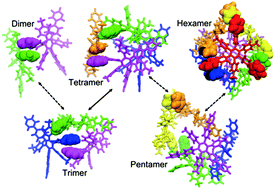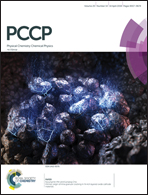Programed dynamical ordering in self-organization processes of a nanocube: a molecular dynamics study†
Abstract
Self-organization processes of a gear-shaped amphiphile molecule (1) to form a hexameric structure (nanocube, 16) were inferred from sequential dissociation processes by using molecular dynamics (MD) simulations. Our MD study unveiled that programed dynamic ordering exists in the dissociation processes of 16. According to the dissociation processes, it is proposed that triple π-stacking among three 3-pyridyl groups and other weak molecular interactions such as CH–π and van der Waals interactions, some of which arise from the solvophobic effect, were sequentially formed in stable and transient oligomeric states in the self-organization processes, i.e.12, 13, 14, and 15. By subsequent analyses on structural stabilities, it was found that 13 and 14 are stable intermediate oligomers, whereas 12 and 15 are transient ones. Thus, the formation of 13 from three monomers and of 16 from 14 and two monomers via corresponding transients is time consuming in the self-assembly process.

- This article is part of the themed collection: 2018 PCCP HOT Articles


 Please wait while we load your content...
Please wait while we load your content...